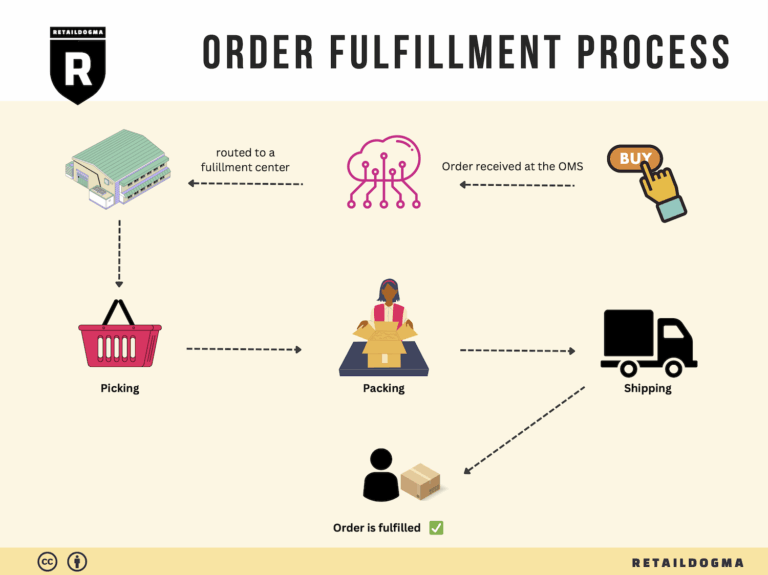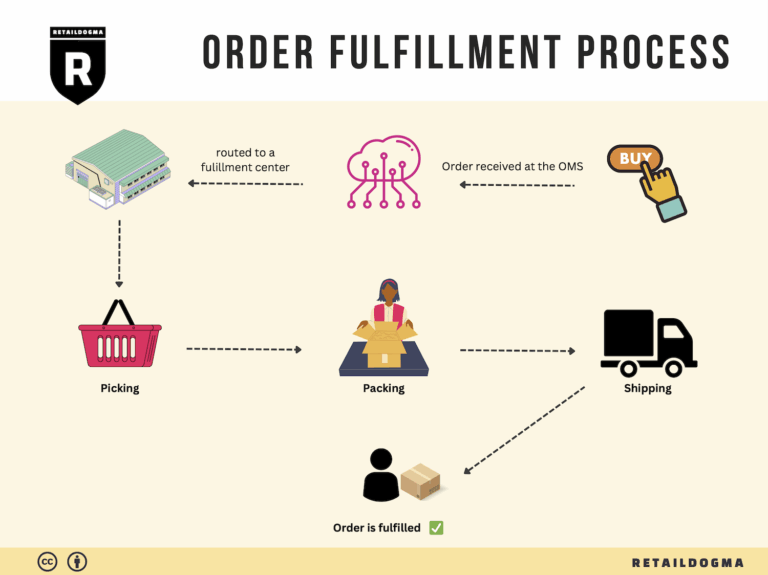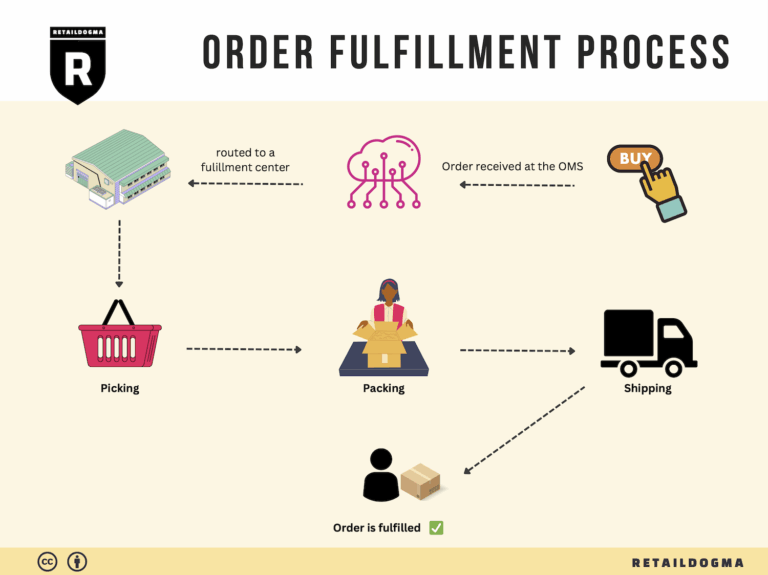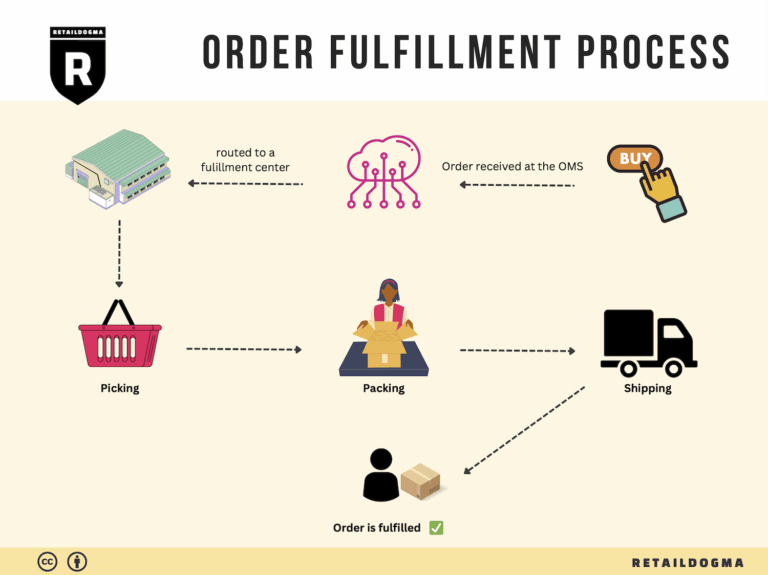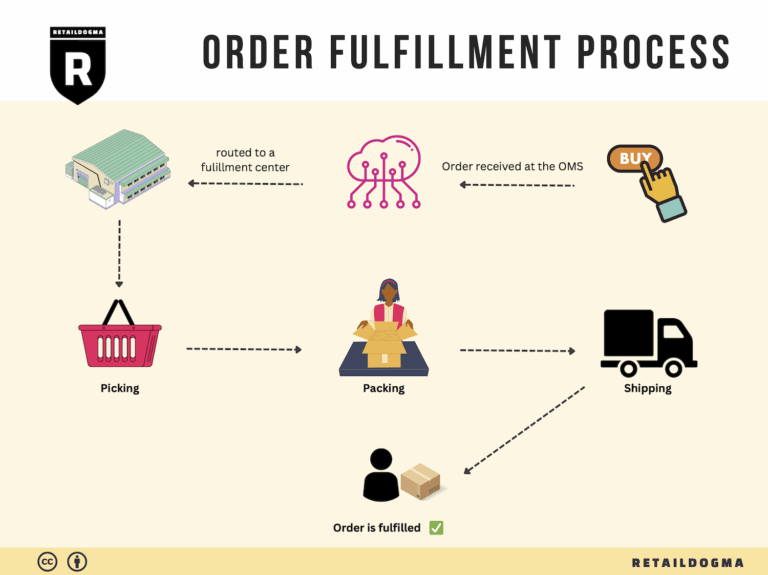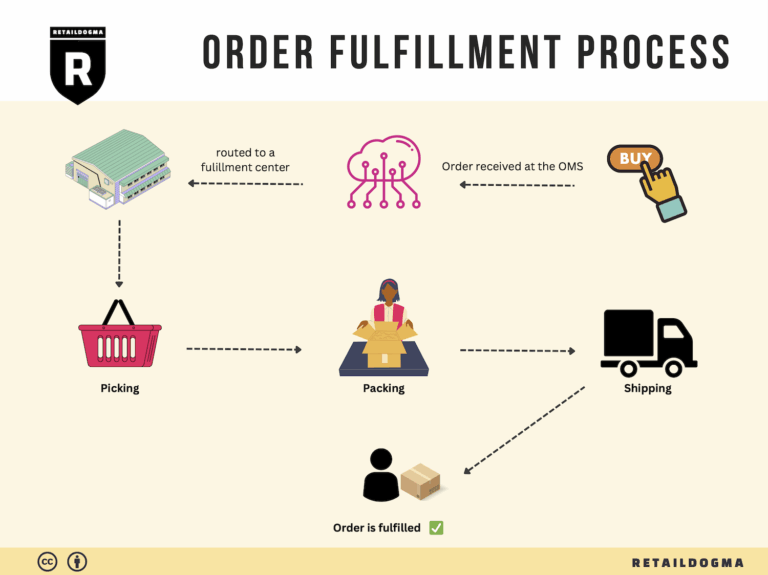What Is A Fulfillment Center? A Complete Guide (2025)
What is E-commerce Fulfillment? An Introduction for Growing Businesses
The Challenges of Packing and Shipping Orders
As an e-commerce business owner, you may find yourself grappling with the overwhelming task of packing and shipping orders. The excitement of launching your products can quickly diminish when faced with the logistical nightmare of inventory management, order fulfillment, and shipping processes. This is a common pain point for many growing online businesses, where managing the backend operations can become as daunting as attracting customers.
Understanding Fulfillment
At its core, e-commerce fulfillment is the entire process of getting a product from your warehouse (or supplier) to your customer’s doorstep. This includes receiving inventory, storing it, processing orders, packing items, shipping, and managing returns. A seamless fulfillment process is crucial not only for operational efficiency but also for customer satisfaction. Poor fulfillment can lead to delays, errors, and ultimately, lost sales.
What This Guide Will Cover
In this guide, we will break down the complexities of e-commerce fulfillment into manageable components. We will explore different fulfillment models, including Third-Party Logistics (3PL) and Fulfillment by Amazon (FBA), each with its own advantages and challenges. Understanding these models will help you identify which is best suited for your business needs.
We will also delve into the core services typically offered by fulfillment partners, such as inventory management, order processing, packing, shipping, and customer service. Knowing what to expect from these services can empower you to make informed decisions when selecting a fulfillment partner.
Choosing the right fulfillment partner is pivotal to your business’s success. We will provide criteria and questions to consider, helping you evaluate potential partners based on your specific operational requirements and growth aspirations.
Finally, we will address pricing strategies and what factors influence the cost of fulfillment services. Understanding the financial implications of different fulfillment options can help you budget effectively and maximize your profit margins.
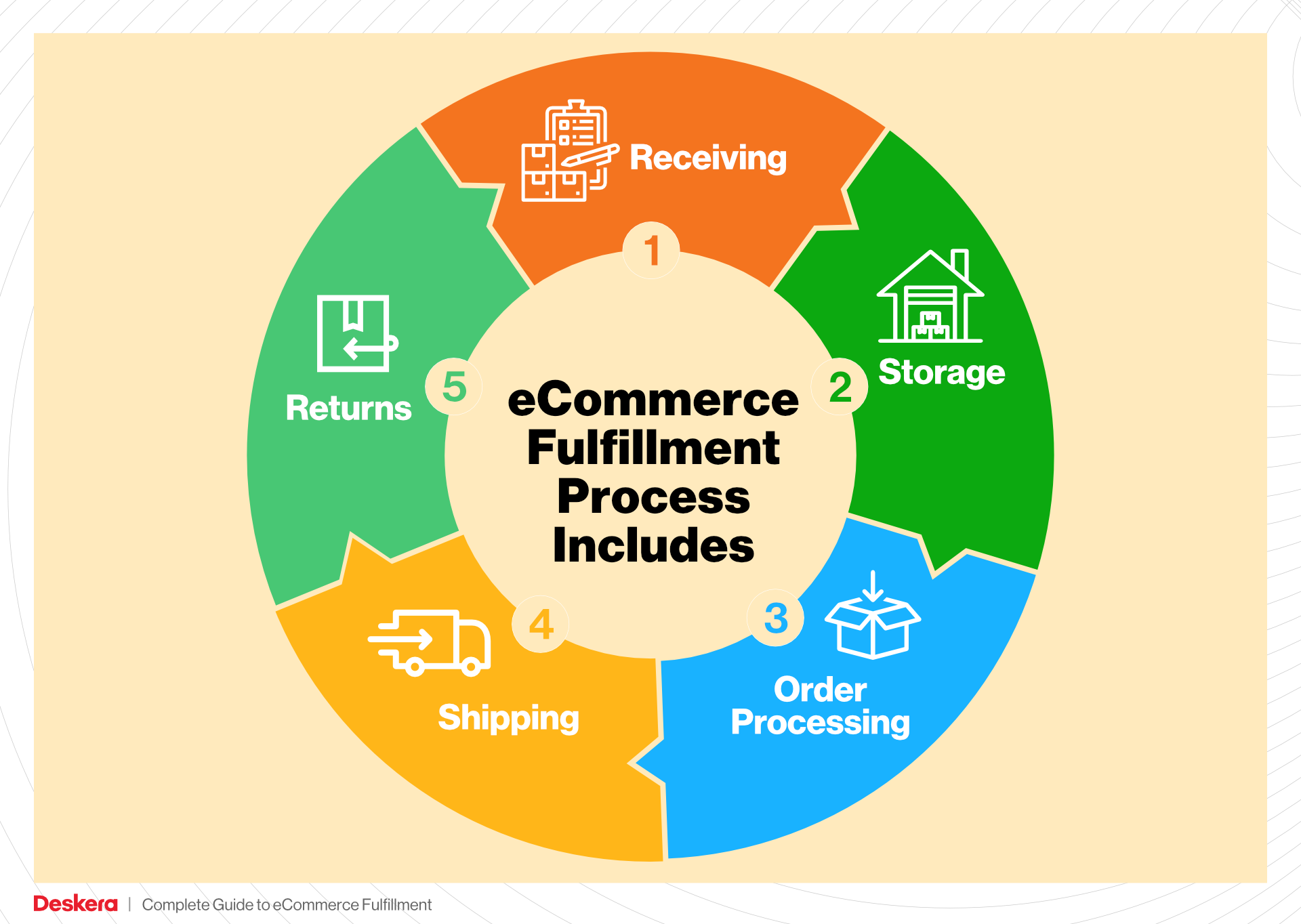
Empowering Smart Logistics Decisions
The ultimate goal of this guide is to empower you to make intelligent, strategic decisions about your logistics operations. By demystifying the fulfillment process and providing actionable insights, you will be better equipped to streamline your operations, enhance customer satisfaction, and scale your business effectively. Whether you’re just starting or looking to refine your existing processes, this guide serves as a comprehensive resource for navigating the complexities of e-commerce fulfillment.
What You’ll Learn In This Guide
- What is E-commerce Fulfillment? An Introduction for Growing Businesses
- The Order Fulfillment Process: From ‘Buy’ Button to Customer’s Door
- Comparing Fulfillment Models: In-House vs. 3PL vs. Dropshipping
- A Deep Dive into Amazon FBA: Pros, Cons, and Who It’s For
- Core Services Offered by Fulfillment Centers
- How to Choose a Fulfillment Partner: A 6-Point Checklist
- Understanding Fulfillment Pricing: A Breakdown of Common Fees
- Frequently Asked Questions (FAQs) about Fulfillment
- Conclusion: Is Outsourcing Fulfillment the Right Move for Your Business?
- Important Disclaimer
The Order Fulfillment Process: From ‘Buy’ Button to Customer’s Door
1. Receiving Inventory
The order fulfillment process begins with receiving inventory at the fulfillment center. This step is crucial as it sets the foundation for all subsequent operations. When products arrive at the Amazon fulfillment center, they are scanned and logged into the inventory management system using Stock Keeping Units (SKUs). Each SKU acts as a unique identifier for products, enabling accurate tracking and management throughout the fulfillment process.
Proper receiving procedures help in identifying discrepancies between what was ordered and what was received, preventing inventory shortages or surpluses. This step is essential for maintaining accurate stock levels, which directly impacts your ability to fulfill customer orders promptly. A well-organized receiving process also ensures that damaged or incorrect items are flagged and addressed immediately, preserving the integrity of your inventory.
2. Warehouse Storage
Once the inventory is received and logged, it moves to the warehouse storage phase. Efficient storage solutions are vital for maximizing space and ensuring easy access to products. In Amazon fulfillment centers, items are typically stored based on size, type, and demand. Utilizing a system known as ‘random storage’ allows for flexible placement of products, which optimizes warehouse space and reduces the time needed to locate items.
The importance of effective warehouse storage cannot be overstated; it directly influences picking efficiency and overall order fulfillment speed. By strategically organizing inventory, businesses can minimize search times and streamline operations, ultimately leading to faster shipping times and improved customer satisfaction.
3. Order Picking
When a customer places an order, the next step is order picking, where items are retrieved from storage to fulfill the order. In fulfillment centers like Amazon RFD2, this process is often facilitated by using pick lists, which outline the items and their respective locations in the warehouse. This systematic approach ensures that the right products are selected quickly and accurately.
The efficiency of the picking process is critical; delays or errors at this stage can lead to missed deadlines and dissatisfied customers. Implementing technologies such as barcode scanners and mobile picking devices can further enhance accuracy and speed, allowing staff to work more effectively. A streamlined picking process not only improves operational efficiency but also supports scalability as your business grows.
4. Order Packing
After picking, the next step is order packing. This phase involves carefully packaging the items to ensure they arrive at the customer’s doorstep in perfect condition. Proper packing is essential for preventing damage during transit and can significantly influence customer satisfaction. Utilizing packing slips that include order details helps in verifying that the correct items are included before sealing the package.
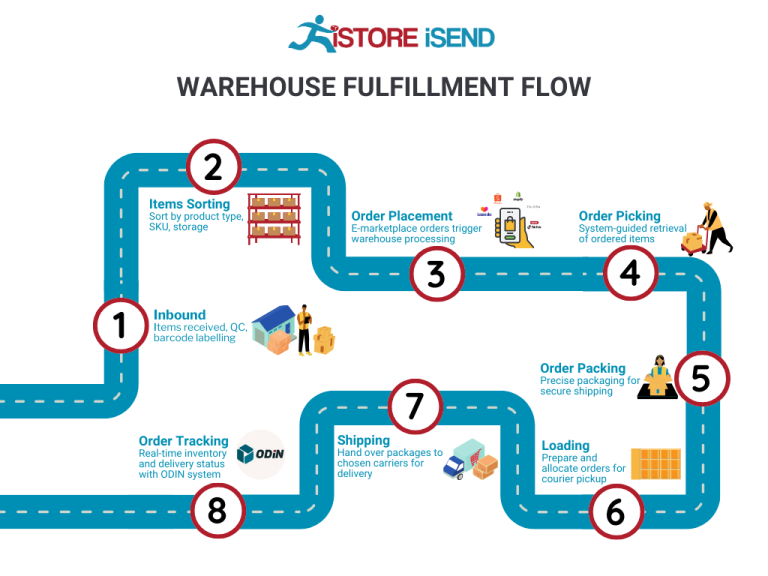
Additionally, businesses should consider using the right-sized boxes and protective materials to minimize shipping costs while ensuring product safety. An effective packing strategy can help reduce returns due to damage, improve shipping efficiency, and enhance the overall customer experience. As your business scales, investing in automated packing solutions may also be worthwhile to increase throughput and maintain consistency.
5. Shipping & Delivery
The final step in the order fulfillment process is shipping and delivery. Once packages are packed, they are labeled and sorted for shipment based on delivery destinations. This phase is critical, as timely delivery is often a key differentiator in customer satisfaction. Utilizing shipping software can help optimize shipping routes and costs, ensuring that packages reach customers as quickly and efficiently as possible.
Monitoring delivery performance metrics, such as on-time delivery rates and shipping costs, is essential for continuous improvement. In the competitive landscape of e-commerce, reliable shipping not only enhances customer loyalty but also strengthens your brand’s reputation. As you scale your operations, establishing partnerships with various carriers can provide flexibility and options to meet diverse customer needs.
By understanding and optimizing each step of the order fulfillment process—from receiving inventory to shipping and delivery—business owners and operations managers can create a robust logistics framework that supports growth and enhances the customer experience.
Comparing Fulfillment Models: In-House vs. 3PL vs. Dropshipping
Fulfillment Model Comparison
| Model | Who Handles Inventory | Best For (Business Stage) | Key Advantage | Key Disadvantage |
|---|---|---|---|---|
| In-House Fulfillment | Business Owner | Startups to Established | Full control over inventory and processes | High operational costs and resource demands |
| Third-Party Logistics (3PL) | 3PL Provider | Growing Businesses | Scalability and expertise in logistics | Less control over inventory and potential delays |
| Dropshipping | Supplier | Startups and Small Businesses | Low upfront costs and inventory risk | Lower profit margins and reliance on suppliers |
In-House Fulfillment
In-house fulfillment involves managing the entire inventory and order fulfillment process within your own business operations. This model is ideal for businesses that are either startups looking to establish a strong brand identity or established companies that want to maintain complete control over their supply chain. The key advantage of in-house fulfillment is the ability to oversee every aspect of the logistics process, from inventory management to order shipping. This hands-on approach allows businesses to implement strict quality control measures and customize the fulfillment process to align with their branding and customer service standards.
However, the in-house model comes with significant disadvantages. It requires substantial investment in warehousing, staffing, and technology, which can be a financial burden for startups or small businesses. Additionally, the operational demands can stretch resources thin, especially during peak seasons or unexpected surges in order volume. For many businesses, the operational complexity can detract from focusing on core competencies such as product development or marketing.
Third-Party Logistics (3PL)
Utilizing a third-party logistics provider (3PL) allows businesses to outsource their fulfillment processes to specialized companies that handle warehousing, shipping, and logistics. This model is particularly advantageous for growing businesses that experience fluctuating order volumes and want to scale quickly without the overhead associated with in-house operations. 3PLs offer expertise in logistics management, access to advanced technology, and established networks for shipping and distribution.
One of the primary benefits of using a 3PL is the scalability it offers. Businesses can easily adjust their fulfillment operations based on demand, which is especially useful during peak seasons or promotional campaigns. Additionally, 3PLs often have relationships with carriers that can lead to reduced shipping costs and faster delivery times. However, the key disadvantage is the potential loss of control over inventory management. Depending on the 3PL, businesses may experience delays in shipping or issues with inventory accuracy, which can impact customer satisfaction. Furthermore, the fees associated with 3PL services can add up, affecting profit margins.
Dropshipping
Dropshipping is a fulfillment model where the retailer does not hold inventory but instead transfers customer orders directly to a supplier or manufacturer who then ships the products directly to the customer. This model is particularly appealing for startups and small businesses looking to enter the market with minimal financial risk. The primary advantage of dropshipping is the low upfront costs associated with not having to invest in inventory. Entrepreneurs can test various products without the financial burden of purchasing and storing stock.
However, dropshipping also has notable drawbacks. The profit margins tend to be lower compared to other models, as retailers must pay the supplier’s price, which includes their markup. Additionally, dropshipping places significant reliance on suppliers for inventory management and order fulfillment. Any issues on the supplier’s end, such as stock shortages or shipping delays, can directly affect the retailer’s reputation and customer satisfaction. This lack of control can lead to inconsistent service levels, making it a less favorable option for businesses aiming to build a strong, reliable brand.
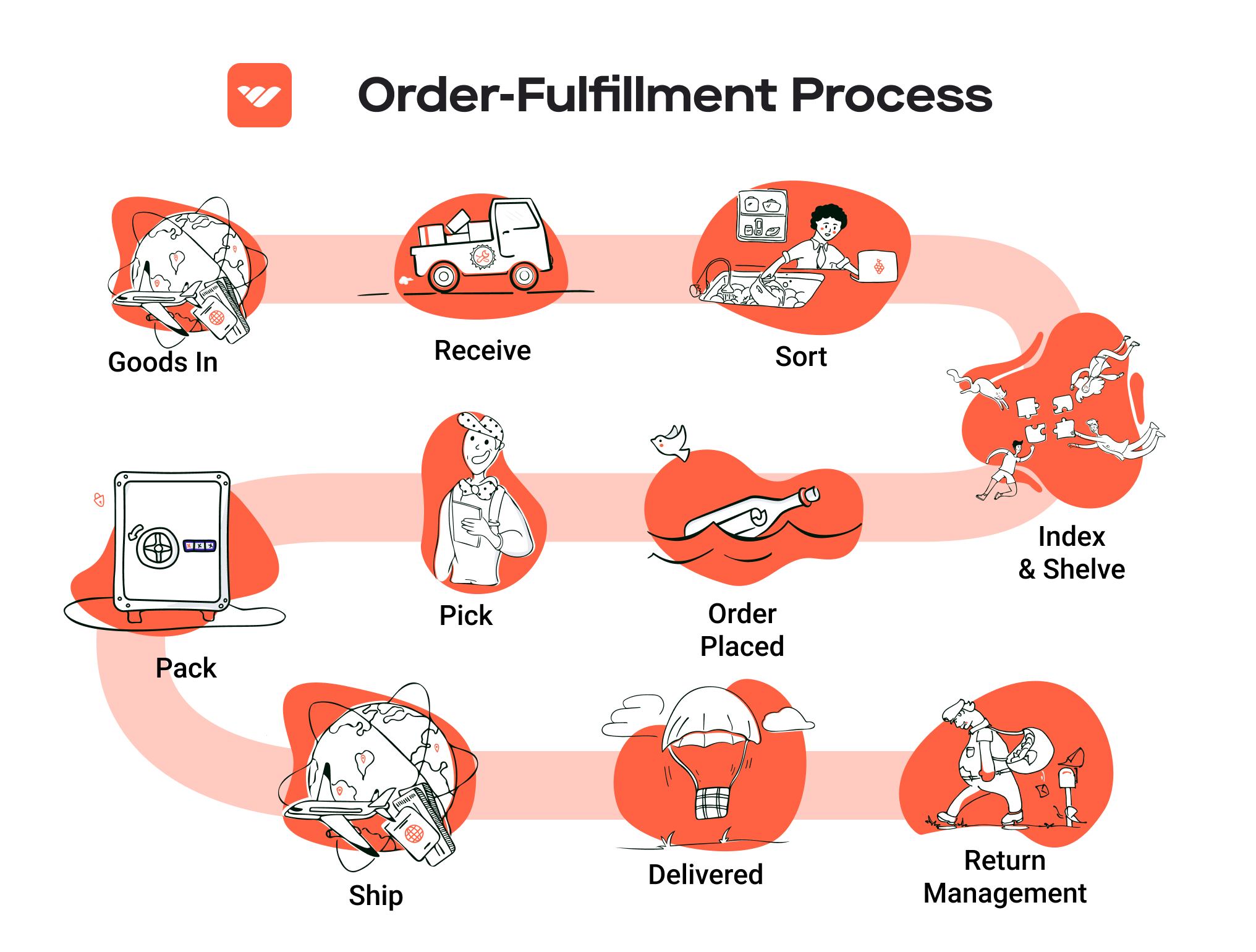
Conclusion
Selecting the right fulfillment model is critical for e-commerce success and depends on various factors, including business stage, financial capacity, and operational preferences. In-house fulfillment offers complete control and customization but demands significant resources, while 3PLs provide scalability and logistics expertise at the cost of some control. Dropshipping presents an accessible entry point for new businesses but comes with challenges related to profit margins and supplier reliability. Understanding these models’ strengths and weaknesses allows business owners to make informed decisions that align with their operational goals and growth strategies.
A Deep Dive into Amazon FBA: Pros, Cons, and Who It’s For
Understanding Fulfillment by Amazon (FBA)
Fulfillment by Amazon (FBA) is a service provided by Amazon that allows sellers to store their products in Amazon’s fulfillment centers. Amazon takes care of storage, packaging, and shipping, as well as customer service and returns for these products. This service simplifies the logistics side of e-commerce for sellers, enabling them to focus more on sales and marketing while leveraging Amazon’s extensive infrastructure and expertise.
How FBA Works
When you enroll in FBA, you send your inventory to Amazon’s fulfillment centers. Once your products are stored in their warehouses, you create product listings on Amazon. When a customer places an order, Amazon handles the entire fulfillment process:
- Storage: Your products are stored in Amazon’s warehouses, which are strategically located to facilitate fast shipping.
- Order Processing: Once an order is placed, Amazon picks, packs, and ships the product directly to the customer.
- Customer Service: Amazon provides customer support for your orders, handling inquiries and returns on your behalf.
- Prime Eligibility: FBA products automatically qualify for Amazon Prime, allowing them to reach a broader audience of Prime members.
This end-to-end service allows sellers to scale their businesses without the need for significant investment in warehousing or logistics.
Pros of Fulfillment by Amazon
-
Prime Eligibility: FBA products are eligible for Amazon Prime, which can significantly boost sales. Prime members tend to spend more and expect fast shipping, making your products more appealing when they see the Prime badge.
-
Customer Trust: Leveraging Amazon’s brand reputation can instill confidence in customers. When they see that a product is fulfilled by Amazon, they are likely to trust that they will receive their orders on time and in good condition.
-
Multi-Channel Fulfillment: FBA can also fulfill orders from other sales channels, such as your own website or eBay. This flexibility allows you to centralize your inventory and streamline your fulfillment processes across different platforms.
-
Scalability: FBA makes it easier to scale your business. As your sales grow, you can ship more inventory to Amazon without needing to worry about logistics and warehousing.
-
Time Savings: By outsourcing logistics to Amazon, sellers save time on packing and shipping, allowing them to focus on product development, marketing, and customer engagement.
-
Comprehensive Analytics: Amazon provides sellers with a wealth of data about their inventory and sales, which can be invaluable for making informed business decisions.
Cons of Fulfillment by Amazon
-
High Fees: FBA comes with various fees, including storage fees for keeping products in Amazon warehouses and fulfillment fees based on the size and weight of your items. These costs can add up, especially for low-margin products.
-
Strict Inventory Rules: Amazon has stringent rules regarding inventory management, including minimum and maximum limits for storage. Sellers must also comply with Amazon’s guidelines on labeling, packaging, and shipping their products to avoid penalties.
-
Commingling Risks: When you use FBA, your products may be commingled with similar products from other sellers. This can lead to issues such as mislabeling or receiving returns for products that are not yours, potentially affecting your brand reputation.
-
Limited Control Over Shipping: While Amazon handles logistics, sellers have little control over shipping times and methods. This can be problematic if you have specific delivery requirements or if there are delays in Amazon’s fulfillment process.
-
Potential for Stockouts: If you do not manage your inventory levels effectively, you risk running out of stock. This can impact your sales, especially if you rely heavily on Prime customers who expect fast shipping.
-
Complex Returns Process: While Amazon manages returns, this can sometimes lead to confusion for sellers, especially if items are returned that do not match the original shipment, or if the return process does not align with your own policies.
Who is FBA Best For?
Fulfillment by Amazon is best suited for:
-
Small to Medium-Sized Sellers: Businesses that want to scale their operations without investing heavily in logistics and warehousing can benefit significantly from FBA. It allows them to focus on growing their brand rather than managing inventory.
-
Brands Looking for Exposure: Sellers who want to leverage Amazon’s vast customer base and Prime membership can gain a competitive edge by utilizing FBA.
-
Multi-Channel Retailers: Brands that sell across different platforms and want to centralize their fulfillment processes can utilize FBA to streamline operations while maintaining inventory control.
-
Sellers with High Turnover Products: If you have products that sell quickly, FBA can help you keep up with demand without the complexities of managing shipping and storage.
-
Entrepreneurs Testing New Products: FBA can serve as an effective way to test new products without the risk of significant upfront investment in logistics.
In conclusion, Fulfillment by Amazon offers a robust solution for e-commerce sellers looking to streamline their logistics and expand their reach. While it presents certain challenges, the benefits of leveraging Amazon’s infrastructure often outweigh the drawbacks, particularly for those aiming to grow their business in a competitive marketplace.
Core Services Offered by Fulfillment Centers
Inventory Management & Warehousing
Inventory management and warehousing are foundational services provided by fulfillment centers, crucial for e-commerce businesses aiming to scale efficiently. This service encompasses the systematic tracking, storing, and handling of products from the point of receipt until they are shipped to customers.
What It Is:
Fulfillment centers utilize advanced inventory management systems to monitor stock levels in real-time, ensuring that businesses maintain optimal inventory levels. This includes receiving goods, storing them in designated areas, and regularly updating inventory data to reflect sales and restocking activities.
Benefits:
1. Accuracy and Efficiency: Automated inventory management reduces human errors associated with manual tracking, leading to more accurate stock levels. This accuracy helps prevent stockouts and overstock situations, which can be costly.
2. Space Optimization: Fulfillment centers are designed to maximize space utilization, allowing businesses to store a larger variety of products without the overhead of maintaining their own warehouse.
3. Scalability: As businesses grow, fulfillment centers can easily adjust storage capabilities to accommodate increased inventory without the need for additional investment in real estate or management systems.
4. Data Insights: Many fulfillment centers provide analytics on inventory turnover rates and sales trends, which can help businesses make informed decisions about purchasing and marketing strategies.
Pick and Pack Services
Pick and pack services are integral to the order fulfillment process, directly impacting customer satisfaction and operational efficiency for e-commerce businesses.
What It Is:
This service involves selecting items from the warehouse based on customer orders (picking) and then packaging them for shipment (packing). Fulfillment centers employ trained staff and automated systems to ensure that orders are filled accurately and efficiently.
Benefits:
1. Speed and Efficiency: Fulfillment centers are equipped with optimized picking systems that streamline the process, allowing for quicker turnaround times on orders. Faster shipping enhances customer satisfaction and can lead to repeat business.
2. Accuracy in Fulfillment: By utilizing barcodes and scanning technology, fulfillment centers minimize the risk of errors during the picking process, ensuring that customers receive exactly what they ordered.
3. Cost-Effectiveness: Outsourcing pick and pack services can significantly reduce labor costs associated with hiring and training in-house staff. Businesses can leverage the fulfillment center’s expertise and resources instead.
4. Scalability: As order volumes fluctuate, fulfillment centers can quickly adapt to changes in demand, whether it’s during peak seasons or promotional events, without compromising service quality.
Kitting and Assembly
Kitting and assembly services allow e-commerce businesses to streamline their product offerings and enhance their marketability.
What It Is:
Kitting involves bundling multiple products into a single package or kit, which may require assembly or organization before shipping. This service is particularly useful for businesses offering promotional items, gift sets, or subscription boxes.
Benefits:
1. Enhanced Customer Appeal: By offering kits or bundles, businesses can create more attractive product offerings that encourage larger purchases and increase average order values.
2. Simplified Logistics: Kitting reduces the complexity of order processing by allowing businesses to ship multiple items as one cohesive unit, simplifying shipping and inventory management.
3. Cost Savings on Packaging: By combining items into a single package, businesses can reduce overall shipping costs and packaging materials, contributing to sustainability efforts.
4. Customization Opportunities: Kitting services can be tailored to customer preferences, enabling personalized offerings that can improve customer engagement and loyalty.
Returns Management (Reverse Logistics)
Effective returns management is essential for maintaining customer satisfaction and managing operational costs in e-commerce.
What It Is:
Returns management, also known as reverse logistics, refers to the processes involved in handling returned products. This includes receiving returns, assessing their condition, restocking or disposing of items, and updating inventory records accordingly.
Benefits:
1. Customer Retention: A seamless returns process can significantly enhance customer satisfaction, encouraging repeat purchases and positive reviews. Customers are more likely to buy when they know they can return items easily.
2. Operational Efficiency: Fulfillment centers streamline the returns process by quickly assessing the condition of returned items and determining the appropriate next steps, minimizing downtime and lost sales opportunities.
3. Data-Driven Insights: Returns data can provide valuable insights into product performance, helping businesses identify trends in customer preferences and potential issues with product quality.
4. Cost Management: Effective returns management helps businesses recover value from returned products, whether through restocking or refurbishing, thereby minimizing losses associated with returns.
In summary, leveraging the core services offered by fulfillment centers allows e-commerce businesses to enhance operational efficiency, improve customer satisfaction, and ultimately scale their operations effectively. By understanding and utilizing these services, entrepreneurs and operations managers can make strategic decisions that drive growth and profitability in a competitive marketplace.
How to Choose a Fulfillment Partner: A 6-Point Checklist
Location & Warehouse Network
Importance: The geographical location of your fulfillment partner’s warehouses can significantly affect shipping times, costs, and overall customer satisfaction. A strategically placed warehouse network enables quicker deliveries to your target markets, reducing shipping costs and improving service levels.
Questions to Ask:
– What is the location of your warehouses, and how do they align with my customer base?
– Do you have a multi-warehouse strategy that allows for regional distribution?
– What shipping carriers do you partner with, and how do those relationships enhance delivery capabilities?
Technology & Integrations
Importance: The technology used by your fulfillment partner plays a crucial role in ensuring seamless operations. A robust fulfillment system should integrate with your e-commerce platform, inventory management, and other tools, allowing for real-time tracking and efficient order processing.
Questions to Ask:
– What technology platforms do you use for order management and inventory tracking?
– Are your systems compatible with popular e-commerce platforms (e.g., Shopify, Amazon, WooCommerce)?
– Can I access real-time data regarding inventory levels, order status, and shipping updates?
Specializations (e.g., cold storage, oversized items)
Importance: Depending on the nature of your products, it’s essential to choose a fulfillment partner that specializes in handling specific types of items. If you deal with perishables, fragile items, or oversized goods, look for partners with the necessary facilities and expertise.
Questions to Ask:
– What types of products do you specialize in handling?
– Do you offer specialized storage solutions, such as climate control for perishables or secure handling for high-value items?
– Can you accommodate unique packaging or handling requirements for my products?
Scalability & Capacity
Importance: As your business grows, your fulfillment needs will evolve. A capable fulfillment partner should be able to scale operations to meet increased demand without sacrificing service quality. Understanding their capacity to manage fluctuations in order volume is critical.
Questions to Ask:
– What is your current capacity for handling orders, and how do you manage peak seasons?
– Can you accommodate sudden increases in order volume, and what is your process for scaling up operations?
– Do you have a history of successfully managing growth for similar-sized businesses in my industry?
Pricing and Contracts
Importance: Transparent pricing is essential to ensure that your logistics costs remain manageable as you scale. It’s crucial to understand the fee structure, including any hidden costs, to avoid surprises that could impact your bottom line.
Questions to Ask:
– What is your pricing model (e.g., per order, per item, monthly fees)?
– Are there any additional fees for services like returns, storage, or handling of special items?
– What are the terms of your contracts, and is there flexibility for renegotiation as my business evolves?
Customer Support & Reviews
Importance: Effective customer support can significantly impact your operations. In the fast-paced world of e-commerce, issues can arise unexpectedly, and having a responsive support team can help mitigate disruptions. Additionally, reviews and testimonials from other businesses can provide insights into the reliability and quality of service.
Questions to Ask:
– What customer support channels do you offer (e.g., phone, email, chat)?
– What are your response times for support inquiries, and how is your support team structured?
– Can you provide references or case studies from similar businesses that have worked with you?
Conclusion
Choosing the right fulfillment partner is a critical decision that can influence your business’s efficiency, customer satisfaction, and overall success. By following this checklist and asking the right questions, you can ensure that you select a partner who aligns with your operational needs and growth ambitions. Remember, the ideal fulfillment partner will not only meet your current requirements but also support your business as it scales and evolves in the ever-changing e-commerce landscape.
Understanding Fulfillment Pricing: A Breakdown of Common Fees
Initial Setup Fees
When you begin utilizing a fulfillment service like Amazon’s RFD2, the initial setup fees are often the first cost you’ll encounter. These fees typically cover the onboarding process, including account setup, integration with your e-commerce platform, and any necessary training on how to use the fulfillment system effectively.
The calculation of these fees can vary significantly depending on the complexity of your operations. For instance, if you have a straightforward product line, the setup might be less costly. Conversely, if your business involves multiple product categories or requires custom packaging solutions, expect higher initial fees. Businesses should inquire whether these costs are one-time fees or if there are recurring charges associated with maintenance or updates.
Receiving Fees
Receiving fees are charged when your inventory arrives at the fulfillment center. This fee accounts for the labor and resources needed to unload, inspect, and store your products.
Typically, receiving fees are calculated based on the volume of your shipment, often measured in weight or units. For example, you might be charged a flat rate per pallet or per box received. It’s crucial to provide accurate inventory counts and shipment details to avoid discrepancies that could lead to additional costs. Understanding your shipping frequency and volume will help you project these fees accurately.
Storage Fees (per pallet/bin)
Storage fees are incurred for the space your inventory occupies in the fulfillment center. These fees can be charged monthly and are usually calculated on a per pallet or per bin basis.
Storage costs can vary based on the time of year, as peak seasons like Q4 often see increased rates due to higher demand for warehouse space. Additionally, some fulfillment centers may implement tiered pricing, where the cost per pallet decreases as you store more units. It’s essential to monitor your inventory turnover rates to minimize storage fees—slow-moving products can lead to increased costs if they remain in storage too long.
Pick & Pack Fees (per item/order)
Pick and pack fees are charged for the labor involved in selecting items from inventory and packaging them for shipment. This fee is crucial for businesses to understand, as it directly impacts the overall cost of fulfilling orders.
These fees are typically calculated based on the number of items in an order. For instance, a flat fee may be applied for each order picked, plus an additional fee for each item included in that order. Some fulfillment centers may offer volume discounts for businesses with high order quantities. To optimize these costs, consider streamlining your product offerings or consolidating orders to reduce the number of picks required.
Shipping Fees
Shipping fees are the final component of fulfillment pricing and can significantly impact your overall costs. These fees cover the transportation of goods from the fulfillment center to your customers and vary based on several factors, including the shipping method, package weight, and destination.
Fulfillment centers often have negotiated rates with carriers, which can benefit businesses by providing lower shipping costs than retail rates. Additionally, businesses must decide between standard, expedited, or same-day shipping options, each carrying different costs. Understanding your customer base and their shipping preferences can help you choose the most cost-effective shipping solutions.
Tips for Getting an Accurate Quote
-
Detail Your Inventory: Provide specific information about your products, including dimensions, weight, and any special handling requirements. This helps fulfillment centers give you a more precise estimate.
-
Understand Your Volume: Be clear about your expected shipping volume and frequency. Some fulfillment centers offer tiered pricing based on volume, which can significantly lower your costs.
-
Ask About Additional Fees: Inquire about any potential additional fees that may apply, such as returns processing, seasonal surcharges, or long-term storage fees.
-
Request a Comprehensive Breakdown: When seeking quotes, ask for a detailed breakdown of all fees associated with the fulfillment process. This transparency will help you understand the total cost and avoid surprises later.
-
Negotiate Terms: Don’t hesitate to negotiate pricing based on your anticipated order volume or for a long-term partnership. Many fulfillment centers are willing to work with businesses to establish mutually beneficial terms.
By understanding these common fulfillment pricing models and following these tips, you can better navigate the complexities of e-commerce logistics and find a solution that supports your business growth effectively.
Frequently Asked Questions (FAQs) about Fulfillment
1. What is Amazon Fulfillment Center RFD2?
Amazon Fulfillment Center RFD2 is a specific warehouse located in Huntley, Illinois, with a total area of approximately 629,186 square feet. It serves as a logistics hub for Amazon’s operations, facilitating the storage, packing, and shipping of products to customers across the United States.
2. How does RFD2 fit into Amazon’s fulfillment network?
RFD2 is part of Amazon’s extensive fulfillment network, which includes various types of facilities designed to optimize the supply chain. This center specifically focuses on receiving, storing, and fulfilling orders for a wide range of products, helping Amazon to meet its fast shipping promises to customers.
3. What types of products are typically stored at RFD2?
RFD2 handles a variety of products, including electronics, household goods, clothing, and more. The center is equipped to manage both small and bulky items, depending on demand and inventory needs.
4. What’s the difference between a warehouse and a fulfillment center?
A warehouse primarily focuses on storing goods, whereas a fulfillment center is designed to handle the entire process of order fulfillment, including receiving inventory, picking, packing, and shipping orders to customers. Fulfillment centers also often provide additional services such as returns management and customer service.
5. What is a 3PL (Third-Party Logistics)?
A 3PL is a service provider that manages logistics and supply chain functions on behalf of a business. This can include warehousing, transportation, and fulfillment services. Companies often partner with 3PLs to enhance their operational efficiency and scale their logistics capabilities without investing heavily in infrastructure.
6. How much do fulfillment services cost?
Fulfillment costs can vary widely based on factors such as the size of the products, the volume of orders, and the specific services required. Generally, costs may include storage fees, picking and packing fees, shipping costs, and any additional services such as returns processing. It’s essential for businesses to analyze their specific needs to get an accurate estimate.
7. Can I choose which fulfillment center to send my inventory to?
No, sellers cannot select a specific fulfillment center for their inventory. Amazon’s system automatically assigns warehouses based on various factors, including geographic location, product demand, and shipping plans.
8. How can I track my inventory sent to RFD2?
Amazon provides tracking capabilities through its Seller Central platform. Once your inventory is shipped to RFD2, you can monitor its status, including receipt confirmation and inventory levels, ensuring you have visibility throughout the fulfillment process.
9. What should I consider when shipping to RFD2?
When shipping to RFD2, consider the following:
– Shipping Costs: Analyze the most cost-effective shipping methods based on your product size and weight.
– Lead Times: Factor in lead times for both shipping and receiving to manage customer expectations.
– Packaging Requirements: Ensure that your products are packaged according to Amazon’s guidelines to avoid any delays or rejections upon arrival.
10. How does RFD2 impact my business’s scalability?
Utilizing RFD2 as part of your fulfillment strategy can significantly enhance your business’s scalability. With Amazon’s extensive logistics network, businesses can efficiently manage inventory, reduce shipping times, and improve customer satisfaction, allowing for faster growth and the ability to reach new markets.
Conclusion: Is Outsourcing Fulfillment the Right Move for Your Business?
Evaluating the Benefits of Outsourcing Fulfillment
Outsourcing your fulfillment process can be a transformative decision for your e-commerce business, offering key advantages that directly contribute to growth and efficiency. First and foremost, partnering with a fulfillment service allows you to save valuable time. By delegating logistics to experts, you can redirect your focus towards core business activities such as marketing, product development, and customer engagement. This shift not only enhances productivity but also fosters innovation within your organization.
Moreover, scalability is a significant benefit of utilizing a fulfillment partner. As your sales volume fluctuates—whether due to seasonal trends or sudden spikes in demand—an experienced fulfillment service can adjust to your needs without the burdensome overhead of managing warehousing and staffing. This flexibility ensures that you can scale operations seamlessly, maintaining customer satisfaction even during peak periods.
Additionally, fulfillment experts bring a wealth of knowledge and experience to the table. They understand the intricacies of logistics, including optimizing shipping routes and managing inventory effectively. This expertise minimizes the risk of costly errors and enhances the overall efficiency of your supply chain.
However, it is critical to choose the right fulfillment partner. The effectiveness of your outsourcing strategy hinges on finding a provider that aligns with your business goals, industry requirements, and customer expectations. Conduct thorough due diligence to ensure that the partner you select can support your growth ambitions.
To assess whether outsourcing fulfillment is the right move for your business, take a moment to audit your current shipping processes. Evaluate your operational bottlenecks, costs, and customer feedback. This analysis will help you determine if engaging a fulfillment partner could be a strategic next step toward scaling your operations and enhancing your customer experience.
Important Disclaimer
⚠️ Important Disclaimer
The information in this guide is for educational purposes. Fulfillment services, pricing, and platform features change frequently. Always conduct your own due diligence and consult with providers directly before making business decisions.

